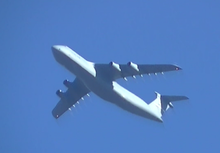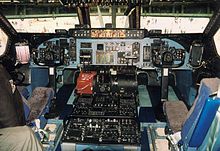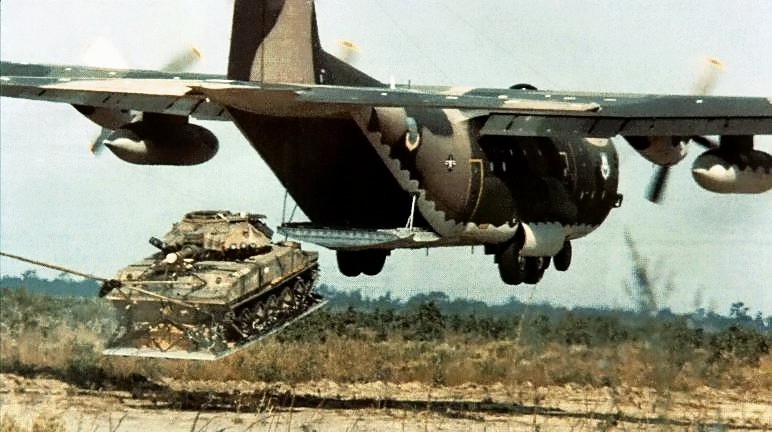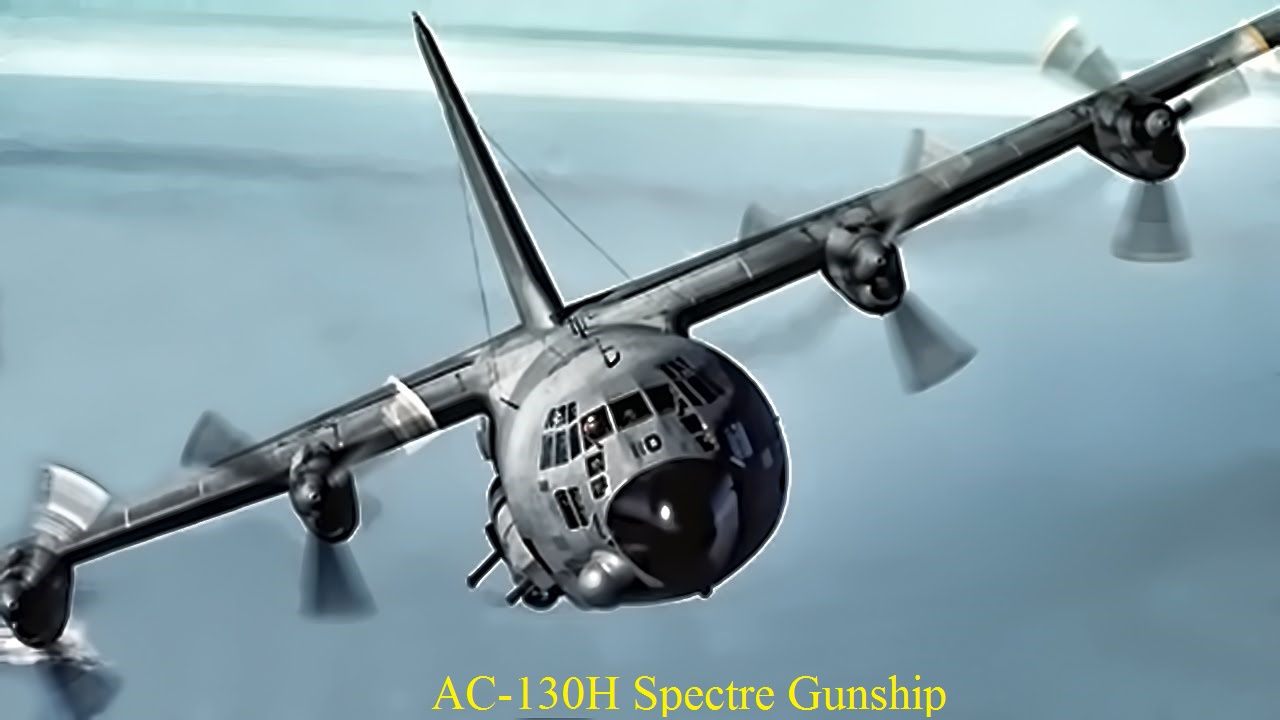Military transport aircraft
| C-5 |
| C-12 |
| C-17 |
| CV-22 |
| VC-25 |
| C-32 |
| C-37 |
| C-21 |
| C-40 |
|
C-130
C-130E: Four Allison T56-A-7 turboprops; 4,200 prop shaft horsepower C-130H: Four Allison T56-A-15 turboprops; 4,591prop shaft horsepower C-130J: Four Rolls-Royce AE 2100D3 turboprops; 4,700 horsepower Speed: C-130E: 345 mph/300 ktas (Mach 0.49) at 20,000 feet (6,060 meters) C-130H: 366 mph/318 ktas (Mach 0.52) at 20,000 feet (6,060 meters) C-130J: 417 mph/362 ktas (Mach 0.59) at 22,000 feet (6,706 meters) C-130J-30: 410 mph/356 ktas (Mach 0.58) at 22,000 feet (6,706 meters) Range with 35,000 pounds of Payload: C-130E, 1,438 miles (1,250 nautical miles) C-130H, 1,496 miles (1,300 nautical miles) C-130J, 1,841 miles (1,600 nautical miles) C-130J-30, 2,417 miles (2,100 nautical miles) |
C-5
|
How big is a c5? There are 28 wheels on the C-5 undercarriage to support not only its more than 380 ton weight, but also the up to 135 tons of cargo that the aircraft can carry. The landing gears are truly massive and they need to be with a gross takeoff weight of 840,000 lbs. Mission The C-5 Galaxy is one of the largest aircraft in the world and the largest airlifter in the Air Force inventory. The aircraft can carry a fully equipped combat-ready military unit to any point in the world on short notice and then provide the supplies required to help sustain the fighting force. Features The C-5 has a greater capacity than any other airlifter. It has the ability to carry 36 standard pallets and 81 troops simultaneously. The Galaxy is also capable of carrying any of the Army's air-transportable combat equipment, including such bulky items as the 74-ton mobile scissors bridge. It can also carry outsize and oversize cargo over intercontinental ranges and can take off or land in relatively short distances. Ground crews are able to load and off-load the C-5 simultaneously at the front and rear cargo openings, reducing cargo transfer times. Other features of the C-5 are: ?Able to operate on runways 6,000 feet long (1,829 meters) ?Five sets of landing gear totaling 28 wheels to distribute weight ?Nose and aft doors that open the full width and height of the cargo compartment to permit faster and easier loading ?A "kneeling" landing gear system that permits lowering the parked aircraft to facilitate drive-on/drive-off vehicle loading and adjusts the cargo floor to standard truck-bed height ?Full-width drive-on ramps at each end for loading double rows of vehicles ?A maintenance diagnostics system that records and analyzes data from more than 800 (C-5A) and 7000 (C-5M) test points, reducing maintenance/repair time. The C-5 has the distinctive high T-tail, 25-degree wing sweep, and four turbofan engines mounted on pylons beneath the wings. The C-5 has 12 internal wing tanks with a total capacity of 51,150 gallons (194,370 liters) of fuel — enough to fill 6 1/2 regular-size railroad tank cars. A full fuel load weighs 332,500 pounds (150,820 kilograms). A C-5 with a cargo load of 270,000 pounds (122,472 kilograms) can fly 2,150 nautical miles, offload, and fly to a second base 500 nautical miles away from the original destination — all without aerial refueling. With aerial refueling, the aircraft's range is limited only by crew endurance.  C-5 Galaxy in-flight shortly after taking off Aircraft Specifications | C-5A/B/C Galaxy General Characteristics
Aircraft Specifications | C-5M Super Galaxy
C-5A: (1998) C-5B: (1998) C-5C: (1998) C-5M: (2009) C-5M Super Galaxy  Instrument panel of a C-5A What is the largest military cargo plane in the world? Antonov AN-124 Ruslan is currently the world's biggest military transport aircraft by take-off weight. A C-5M Super Galaxy of the _______ . The C-17 Globemaster III can carry a maximum payload of 74,797kg. How many tanks can a C 5 carry? The aircraft is able to carry two M1 Abrams main battle tanks, or one Abrams tank plus two M2/M3 Bradley fighting vehicles, or six AH-64 Apache/Apache Longbow attack helicopters. Also, the C-5 is able to carry as many as 15 HMMWV (humvees). |
AC-130
 A C-130 delivering an M551 Sheridan tank using LAPES (Low Altitude Parachute Extraction System). |

|
| Variants |
|
AC-130H Spectre Gunship
AC-130H Spectre Airstrike at Night AC-130U Spooky Airstrike at Night Specifications (A-10A) Specifications (A-10A) General characteristics Crew: 1 Length: 53 ft 4 in (16.26 m) Wingspan: 57 ft 6 in (17.53 m) Height: 14 ft 8 in (4.47 m) Wing area: 506 ft² (47.0 m²) Airfoil: NACA 6716 root, NACA 6713 tip Empty weight: 24,959 lb (11,321 kg) Loaded weight: 30,384 lb (13,782 kg) CAS mission: 47,094 lb (21,361 kg) Anti-armor mission: 42,071 lb (19,083 kg) Max. takeoff weight: 50,000 lb (23,000 kg) Powerplant: 2 × General Electric TF34-GE-100A turbofans, 9,065 lbf (40.32 kN) each Internal fuel capacity: 11,000 lb (4,990 kg) Performance Never exceed speed: 450 knots (518 mph,[174] 833 km/h) at 5,000 ft (1,500 m) with 18 Mk 82 bombs Maximum speed: 381 knots (439 mph, 706 km/h) at sea level, clean Cruise speed: 300 knots (340 mph, 560 km/h) Stall speed: 120 knots (138 mph, 220 km/h) Combat radius: CAS mission: 250 nmi (288 mi, 460 km) at 1.88 hour loiter at 5,000 ft (1,500 m), 10 min combat Anti-armor mission: 252 nmi (290 mi, 467 km), 40 nmi (45 mi, 75 km)) sea-level penetration and exit, 30 min combat Ferry range: 2,240 nmi (2,580 mi, 4,150 km) with 50 knot (55 mph, 90 km/h) headwinds, 20 minutes reserve Service ceiling: 45,000 ft (13,700 m) Rate of climb: 6,000 ft/min (30 m/s) Wing loading: 99 lb/ft² (482 kg/m²) Thrust/weight: 0.36 Armament Guns: 1× 30 mm (1.18 in) GAU-8/A Avenger Gatling cannon with 1,174 rounds (Capacity 1,350) Hardpoints: 11 (8× under-wing and 3× under-fuselage pylon stations) with a capacity of 16,000 lb (7,260 kg) and provisions to carry combinations of: Rockets: 4× LAU-61/LAU-68 rocket pods (each with 19× / 7× Hydra 70 mm rockets, respectively) 4× LAU-5003 rocket pods (each with 19× CRV7 70 mm rockets) 6× LAU-10 rocket pods (each with 4× 127 mm (5.0 in) Zuni rockets) Missiles: 2× AIM-9 Sidewinders air-to-air missiles for self-defense 6× AGM-65 Maverick air-to-surface missiles Bombs: Mark 80 series of unguided iron bombs or Mk 77 incendiary bombs or BLU-1, BLU-27/B Rockeye II, Mk20, BL-755 and CBU-52/58/71/87/89/97 cluster bombs or Paveway series of Laser-guided bombs or Joint Direct Attack Munition (A-10C)[178] or Wind Corrected Munitions Dispenser (A-10C) Other: SUU-42A/A Flares/Infrared decoys and chaff dispenser pod or AN/ALQ-131 or AN/ALQ-184 ECM pods or Lockheed Martin Sniper XR or LITENING targeting pods (A-10C) or 2× 600 US gallon Sargent Fletcher drop tanks for increased range/loitering time. Avionics AN/AAS-35(V) Pave Penny laser tracker pod (mounted beneath right side of cockpit) for use with Paveway LGBs (Currently the Pave Penny is no longer in use) Head-up display (HUD) for improved technical flying and air-to-ground support. AC-130H Spectre / AC-130U Spooky Variants: C-130 - Base transport model AC-130H - Callsign of 'Spectre'; 8 crewmen; Dual 20mm Vulcan, 40mm and 105mm cannons. AC-130U - Callsign of 'Spooky'; 13 crewmen; Varying avionics and sub-systems; Third generation AC-130 gunship variant; Addition of 25mm gun to 40mm and 105mm standard armament. Lockheed AC-130H Spectre / AC-130U Spooky Close Air-Support, Air Interdiction and Force Protection Gunship (1972) Authored By Staff Writer | Last Updated: 11/13/2015 The Lockheed AC-130 is a special-mission gunship variant of the storied C-130 Hercules high-wing transport. Since the advent of the airplane as an instrument of war, warplanners have relied on the power of mobile aerial attacks to keep an enemy on its toes. From the simple dropping of flechettes on entrenched enemy positions in World War One, to the direct contact assaults prevalent in World War Two, this is no more truer than with the converted C-130 series of gunships (known respectively per models as the AC-130H "Spectre" and AC-130U "Spooky"). The Spectre and Spooky systems have evolved to become an important part of the ever-changing battlefield, where contact with enemy forces is likely, and the need for precision yet powerful aerial artillery is evermore important. The AC-130, having been derived from the armed AC-47 gunship series, saw extensive and successful action against enemy forces in the Vietnam War. Appearing very much like the base C-130 transport model - a system that already came into its own as one of the most successful transport designs ever made - but were armed with a lethal array of miniguns, cannons and howitzers. From a basic design perspective, the AC-130 is a shoulder-mounted straight wing system with a single large rudder aft. Four Allison turboprops are mounted underwing, with two per wing. The spacious cargo bay of the base C130 allows for the carrying of the powerful 105mm cannon along with additional weaponry, ammunition and necessary systems. AC-130's gain their lethality through support of troops in contact, often referred to in the short form as "TIC". AC-130 systems are charged with loitering above combat zones, often working in the darkness of night or inclement weather, using advanced targeting and fire control systems to assist ground troops in need. Though mounting an impressive array of armament, the AC-130's are not up to the task of defeating enemy heavy armor or bunkers but can target concrete structures and light armored vehicles with penetrator rounds. Due to the close proximity of engagement to friendly forces, AC-130's often bore sight with live-fire prior to arriving in the target zone. Firing is accomplished from one side of the aircraft only and requires the aircraft to be in a deliberate turn to engage. As a low-flying system, the AC-130 requires air defense threats to be neutralized before entering enemy airspace, though radar jamming and countermeasures are offered the system. The current breed of AC-130 systems break down into two variants designated as the AC-130H and the AC-130U. Different avionics and subsystems aside, the two aircraft share many similarities. In terms of armament however, the AC-130U incorporated a 25mm gun to compliment the standard 40mm cannon and 105mm howitzer. The accepted callsign for the AC-130H series is the threatening "Spectre" while the AC-130U series enjoys the mysterious "Spooky" callsign. Cost estimates per unit in 2001 were slated at $132,400,000 for the AC-130H system and $190,000,000 for the AC-130U system. The AC-130U also employs more crew to function and consists of a pilot, co-pilot, fire control officer, flight engineer, navigator, TV operator, four aerial gunners, a loadmaster, infrared detection set operator and an electronic warfare officer. The AC-130H maintains a crew of just 8 personnel. Seeing action in Vietnam, the AC-130 crews went on to prove the value of the system time and again in Operation Just Cause to retake the tiny island nation of Panama in 1989. From there, Operation Desert Storm threw the AC-130's into action once more, warming crews up for the inevitable action over Bosnia Herzegovina. Currently seeing action in Operation Enduring Freedom, the AC-130 has solidified its place in the US military inventory - for both wartime and even through emergency evacuation of American non-combatants overseas. The AC-130 is kept in limited supply of just eight AC-130H models and thirteen AC-130U models. Text ©2003-2016 www.MilitaryFactory.com. All Rights Reserved. No Reproduction Permitted. Email corrections/comments to MilitaryFactory at Gmail dot com. Specifications for the Lockheed AC-130H Spectre / AC-130U Spooky Close Air-Support, Air Interdiction and Force Protection Gunship Focus Model: Lockheed AC-130H Spectre _________ of Origin: _________ Manufacturer: __________________ Initial Year of Service: 1972 Production Total: 21 Crew: AC-130H: 8 / AC-130U: 13 Length: 97.77 ft (29.8 m) Width: 132.55 ft (40.40 m) Height: 38.39ft (11.70 m) Weight (Empty): 72,891 lb (33,063 kg) Weight (MTOW): 155,003 lb (70,308 kg) Powerplant: 4 x Rolls-Royce Allison T56-A-15 turboprop engines developing 4,910 horsepower each. Maximum Speed: 300 mph (482 kmh; 260 kts) Maximum Range: 2,200 miles (3,540 km) Service Ceiling: 24,856 ft (7,576 m; 4.7 miles) Rate-of-Climb: 0 feet-per-minute (0 m/min) Hardpoints: 0 Armament Suite: AC-130H "Spectre": 2 x 20mm cannons 1 x 40mm cannon 1 x 105mm cannon AC-130U "Spooky": 1 x 25mm gun 1 x 40mm cannon 1 x 105mm cannon |
